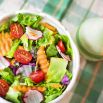Just how bad is the average American diet? According to a recent Yahoo News article, Americans fuel their day by eating mostly ultra-processed food.
The article cites a recent study published in the journal BMJ Open which found out that more than half of the total calories of an average US diet comes from the consumption of ultra-processed food.
Ultra-processed foods introduce to one's diet certain substances that are specifically mentioned in the latest USDA nutritional guidelines such as added sugars, sodium and saturated/trans fats. According to the USDA, intake of these substances should be monitored and kept within recommended levels because of their associations with a number of diseases such as diabetes, obesity, cardiovascular disease and cancer.
What are ultra-processed foods? According to an article in The Atlantic by Marion Nestle, basically all food undergo some processing; for example, an apple is washed and sometimes waxed while drinking water is filtered. However, there are three different types of processing which was identified by Prof. Carlos Monteiro of the University of Sao Paulo, such as:
Three kinds of Food Processing
1. Unprocessed or minimally processed - this does not change the food's nutrition
2. Processed - done by culinary or food industry ingredients which could include the inclusion of oils, fats, flours, starches, salt and sugar and sweeteners. Nutrients are depleted and these processed provide very little nutritional value aside from calorie (where the word empty calorie comes from). Examples of processed foods include canned foods, simple bread and cheese according to HNGN.
3. Ultra-Processed - Uses ingredients found in processed products but to a more extensive degree. According to Marion Nestle's article, the main aim for ultra-processing is durability, attractive, ready-to-eat or ready to heat and convenience. They have unnaturally long shelf life and are extremely palatable that they are often habit-forming. Examples of ultra-processed food include sodas, sweet or savory packaged snacks, candy and desserts, instant noodles and soups, packaged baked goods and reconstituted meat products such as chicken and fish nuggets according to HNGN.
Given the accessibility, convenience, portability, agreeable taste and marketing efforts put into these ultra-processed foods, it is not surprising what the US study found according to the Yahoo News article.
1. Calories from consuming ultra-processed food account for almost 60% of daily calorie intake of the average U.S. diet.
2. Of the observed 60%, added sugars account for an alarming 90 percent, which is measured at 292.2 kcal from added sugar sourced from ultra-processed foods per person daily.
3. Taking a close look at the added sugar source, 17.1% came from soft drinks or sodas, which is the highest percentage-wise. This is followed by fruit drinks, cakes, cookies and pies, bread, desserts, sweet snacks, breakfast cereals and ice cream and ice pops.
4. Highlighting the prevalence of added sugar in ultra-proceed foods even further, the study mentioned that calories from added sugars account for 21.1 % of all calories in ultra-proceeds foods. This is eight times more than added sugar ratio in processed foods which researchers found to constitute only 2.4% of total calories. The added sugar content in ultra-processed food items is five times more than in unprocessed or minimally processed which is measured at only 3.7% of total calories
The study is significant because it finally put into figures what some researchers and anti-sugar groups have always suspected - that the average American diet has way to much-added sugars due to its inclusion of ultra-processed food in greater portions. It also coincides with the latest USDA nutritional regulation guidelines revision, by placing a cap on added sugar in particular (pegged at 10% of total daily calorie intake). From the data provided in the study, added sugars from ultra-processed foods alone stand at almost 54% of total calorie intake (90 percent of 60 percent).
Since this is only an average figure, there are those whose daily calories from added sugars are lesser or greater than the 54%. The study explains that there are even individuals whose calories from added sugar accounts for an astounding 80% of their total energy intake, way above the 10% cap recommended by USDA.
On the other hand, only Americans who ranked within the lowest 20% in terms of ultra-processed food consumption passed the 10% limit set by USDA.
The researchers suggest that based on these findings, decreasing consumption of ultra-processed food could be an effective way to reduce the obviously excessive intake of added sugars in the USA. And it just might be the solution to the soaring obesity rates in the U.S.
© copyright 2024 Food World News, a property of HNGN Inc. All rights reserved. Use of this website constitutes acceptance of our terms and conditions of use and privacy policy.









